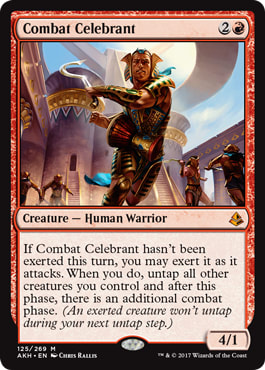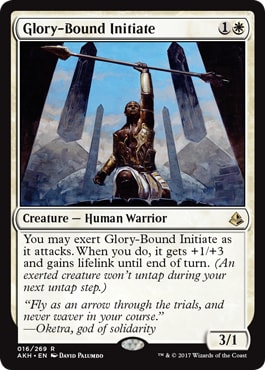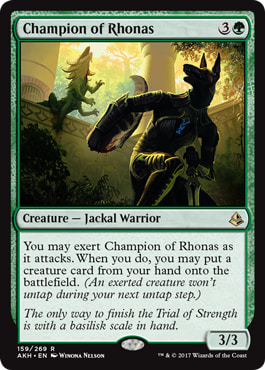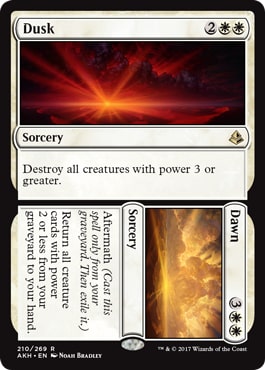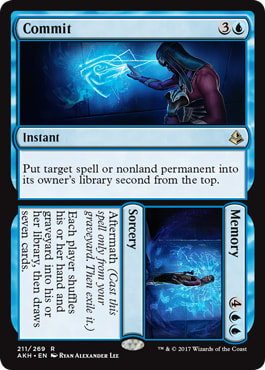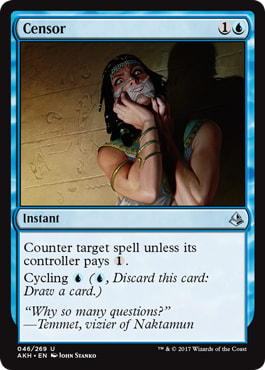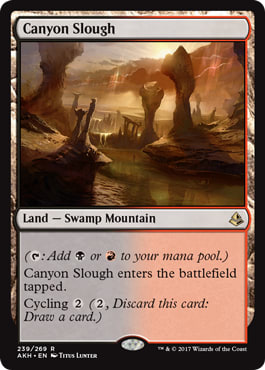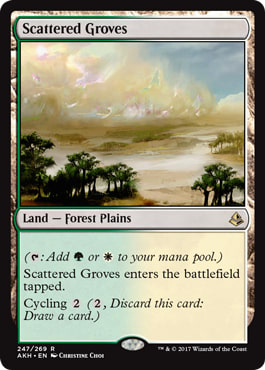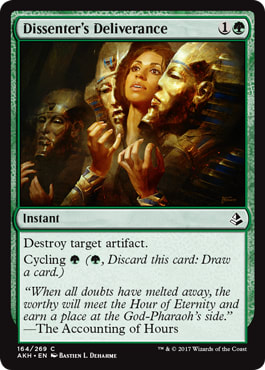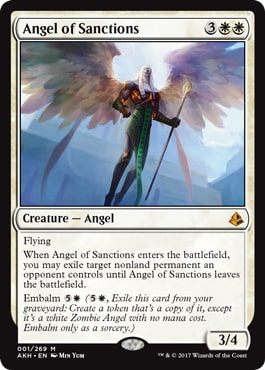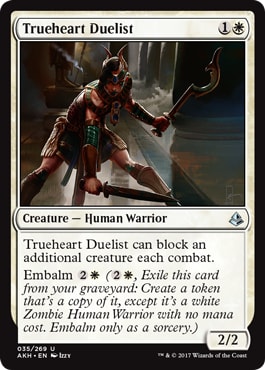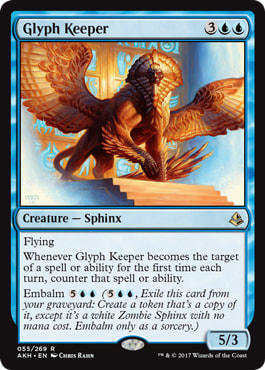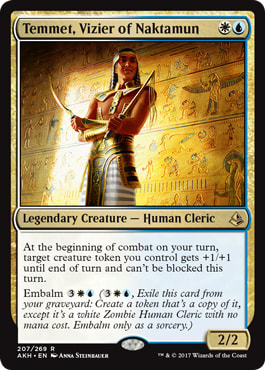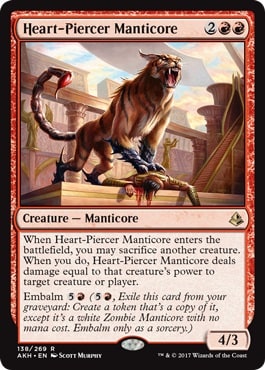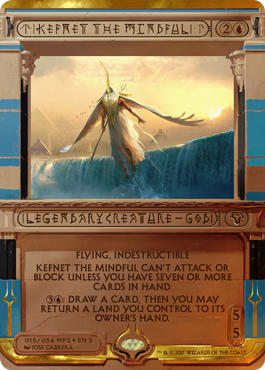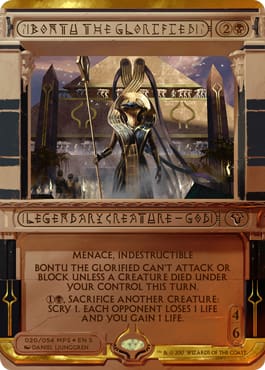Amonkhet represents a lot of new ideas for cards with several new riffs on mechanics and powerful cards for Cube. While Aether Revolt brought some great Cube cards, Amonkhet has already made a huge mark in Cube with a high amount of powerful cards. Many Cube designers that I've talked to have said that this set has given their Cube more cards than any other set in recent history. In this article, I'll be going over them.
Of note: Although this set review has been released after the prerelease, please note that these are based on actual play in my Cube and not merely outsourced to playing at the prerelease or Standard Constructed events. If I'm saying a card has been working well based on my experience, it's based on actual experience from trying them out in my Cube and finding the cards actually have been working well in my Cube.
My 465-powered Cube list is the list used for context and despite inaccurate false dichotomies about how power can warp a Cube, your Cube experience with these cards likely will mirror mine.
As usual, I'll be breaking these down by mechanic before talking about the miscellaneous cards.
Mechanics
Exert
It's easy to dismiss cards with exert due to short-term analysis, since it can be hard to “grok” their impact on the game — overemphasizing how much of a drawback not being able to untap is after exerting, as well as discounting the flexibility of being able to choose to just not do it, factors that generally tend to get exaggerated with card analysis.
Most of the best exert creatures tend to be for aggressive decks, decks that find themselves able to mitigate the drawback of not being able to untap the exerter since, at least in theory, the game's either over or close enough to being over. So, the drawback of being unable to untap shouldn't matter. Let's get started and see how these play out.
Glorybringer is the most powerful exert card and it's a strong contender for the best non-Thundermaw Hellkite Red 5-drop.
I've heard comparisons between it and Flametongue Kavu; and, while it has some similarities being a 4-power creature that deals 4 damage to a (non-Dragon) creature, I found that it was closer to cards like Searing Blaze and just happens to be on a 4/4 flier to boot.
Cards like Searing Blaze are efficient tools for Red aggressive decks since they allow for the deck to push forward momentum while removing a threat, rather than having to take a turn off to do so. Cards like Searing Blaze, Kari Zev's Expertise, and Smash to Smithereens work well on that axis and I've found that Glorybringer works well there too, by killing a blocker and either attacking an opponent or a Planeswalker for 4, similar to Searing Blaze, or just attacking as a consistent source of damage if it doesn't need to kill a blocker.
I found other interesting scenarios with it as well — if it attacks unexerted, it represents being able to remove chump blockers on the next attack. As mentioned above, although it may not feel right, sometimes just getting in there for 4 while representing being able to burn out blockers was great too. While it's true that an opponent can just kill it before it attacks, I found that generally didn't reflect how it actually played out.
Cards like Flametongue Kavu work well in non-aggro decks as they kill something while still being able to hold the fort. Unfortunately, Glorybringer doesn't really do that since it can't block for several turns if it's exerting. Because of that, I've found its primary role is in aggro as a curve topper and is a great Red card for aggro decks although it has seen play in slower Red decks also. It's not as good as Thundermaw Hellkite but it has already made a strong impact with several undefeated results thus far. While Red aggro 5s aren't as important as 1-drops or as needed as 3-drops, it's a great card for aggro decks.
Ahn-Crop Crasher: Since Ahn-Crop Crasher shares many characteristics with Goblin Heelcutter by being a 3-drop (let's be honest, Goblin Heelcutter almost always gets dashed for
Like Glorybringer, even though you generally want to play it in your deck for the exert ability, Ahn-Crop Crasher does so by being a very good on-curve body as a 3/2 haster for 3 without exerting. I've found this is a solid rate even if the opponent doesn't have anything to potentially block. Brazen Scourge got some attention for being a 3/3 haster for ![]()
![]()
![]() and even on that axis, Brazen Scourge compares pretty favorably.
and even on that axis, Brazen Scourge compares pretty favorably.
Like Glorybringer, it also makes potential blocking situations awkward for the opponent as they can't just leave one blocker behind in the face of Ahn-Crop Crasher (unless it has some form of protection from its ability.)
I've talked in previous articles about how attacking 3-drops in Red aren't very numerous, but that trend has been slowly changing as the quality of aggro Red 3s has let that color incorporate 3s that reflect the color's aggressive nature instead of cards like Fire Imp.
Because of this, I've found it to work well in the Red aggressive decks and recommend its use to support Red aggro decks, in a slot that only recently has been getting bolstered.
Combat Celebrant offers an absurd ceiling for being able to double attacks. Unfortunately, I found it to be pretty disappointing. It's gotten attention for working with Kiki-Jiki, Mirror Breaker, but found in Red aggro decks, it really didn't perform well.
Since it doesn't untap itself when exerted, I found that Combat Celebrant generally required too much setup and found that the times when it was correct to exert it were pretty rare (not just in that deck, but in other decks featuring Combat Celebrant.) Oftentimes it'd just attack with a couple of 2/2s and the payoff just wasn't that great for exerting —not even accounting for its vulnerabilities of it having no haste and 1 toughness, making it so that the opponent can see the second attack from a mile away.
I've seen some Cube designers including Combat Celebrant mainly as a tool for helping Kiki combo, rather than a 3-drop to help attacking decks. As cliché as it may sound, its inclusion in your Cube mainly hinges on how deep you want to go with that combo.
Glory-Bound Initiate is one of the best 2-drops for aggro decks since Selfless Spirit. I found that he didn't exert very often since when he was attacking for 3, he was mostly doing what the aggro wanted to do — deal a lot of damage quickly. When he did exert, it was mainly in these scenarios:
- It needed to get through a 2/2 creature, typically joined with some friends. Usually this would incentivize the opponent to trade something else or just take the damage instead of losing their value creature. One of the weaknesses of these Blade of the Sixth Pride types of creatures is that they'd just run into a 1/1 or a 2/2 and trade and exerting helped when those board states came up.
- If in a racing situation, exerting essentially turned it into a 4 point lifegain spell that was still dealing damage, which was sometimes useful.
As White 2-drops generally aren't as important for White aggro decks as 1-drops, I didn't find it as important to take for White aggro decks, but it was still a nice tool to have for those decks. I found that non-aggro decks weren't in the market for a creature that was mostly a 3/1 since it had to attack to really get exert value. Because of this, I would hardly consider this a staple since its role is pretty limited but I wasn't unhappy to see it for aggro White decks either.
Champion is a way to get big creatures into play, but one that's really clunky for Cube. It has some game as a backup plan in midrange decks as a way to cheat out 6-8 drops. It does change the state of the game where the opponent likely will want to kill it ASAP out of fear of it cheating something big and dumb into play next turn (even if you don't) but the creature side of it is very weak as a Hill Giant and it's abysmal if you don't just happen to have something huge to cheat into play and your opponent calls your bluff, which narrows its ability to live up to its ceiling. Green 4-drop creatures are an anemic slot but unfortunately this doesn't really help with that.
Aftermath
While people joke how everything is essentially kicker and this is essentially a riff on flashback but one that offers much more utility. Flashback cards generally fall into the following:
- Ones that required an under-curve spell to get to a good spell (Deep Analysis, Lingering Souls)
- Ones that required casting a relatively on-curve spell with an under-curve spell attached (Firebolt.)
The best of these tend to fall in the second category, by doing something on a decent rate while being a card that lies in wait for the later stages of the game. Think of cards like Chainer's Edict and how they do their thing but offer some utility for the late game if it gets there, but are just fine if the game doesn't go long. Aftermath cards — at least the good ones, tended to play like that.
Dusk // Dawn was the first Aftermath card shown (unofficially) and it offered a unique take as a wrath that aggro decks would want to use, as the decks 2-power creatures would conveniently go under it, so that it'd kill larger blockers that would stonewall the creatures and would later bring the dead creatures back. I tried it aggressively but it turns out that it didn't really deliver on those promises as 4-mana mini-wraths weren't really what aggro decks wanted to spend their mana on, as something that had minimal impact on the game and casting it for Aftermath was too pricey. Non-aggro decks never bothered with casting it either as it'd either kill their own wincons or it was just too unreliable. I'm generally a fan of unique cards that go against the grain, but Dusk // Dawn just didn't seem to have a home.
Commit // Memory was a card that I (as well as others) had dismissed, but seeing this thread got me on board with it. Generally with cards like this, there generally is the need for them to have a good base rate to do something that the deck wants to do and four mana for a Time Ebb/Memory Lapse style of card isn't really efficient. However, I found that it more than made up for it with flexibility, by being able to deal with just about anything.
I found that the Timetwister mode wasn't used often but it was nice when it was (somewhat similarly to the flashback on Chainer's Edict — doesn't come up a whole lot, but it's nice to have.) One awkward thing is that using six mana for said Timetwister effect is that the opponent likely can untap with a full grip while you can't, but that's fine; and, honestly, much of the time it's just gravy to cast in case the opportunity presents itself, which I found tended to be the theme with these cards.
Never // Return played much better than it looked. I found that although the aftermath ability was very inefficient at creating a creature, it was better than Ruinous Path since being able to be cast for ![]()
![]() allowed it to get value after, even if it wasn't for a while in the game. Something like Ruinous Path required a choice to either use it now or lose out on value.
allowed it to get value after, even if it wasn't for a while in the game. Something like Ruinous Path required a choice to either use it now or lose out on value.
I found that it was nice to have as maindeckable graveyard hate, but it depended on how “all in” on reanimation you are, as it was too slow for full-on reanimation but typically was nice for decks that had that as a secondary plan. Black decks have enjoyed it as a nice creature/{laneswalker removal spell while offering some extra utility on top, even if the rate on paying ![]()
![]() for a 2/2 when not hitting something that cared about the graveyard was a poor rate. But then again, it was icing on the cake and generally done when there was either nothing else to do with the mana or to just apply pressure on the board, which made it a solid Black card and Cube addition.
for a 2/2 when not hitting something that cared about the graveyard was a poor rate. But then again, it was icing on the cake and generally done when there was either nothing else to do with the mana or to just apply pressure on the board, which made it a solid Black card and Cube addition.
Insult // Injury — Overrun type of effects tend to suffer in Cube due to how efficient mass removal is, as having an Overrun stuck in hand can be awful if there's nothing to pump, and Overrun's awkward ![]()
![]()
![]()
![]() cost didn't help with that either. Insult // Injury looks innocuous but is better than it looks since I found that it works somewhat similarly to Overrun by doubling the power of creatures and the power of Planeswalker damage or burn. Thistypically meant that cheap burn was cast afterward at an incredible rate. Having a Lunge in the graveyard isn't efficienct as a burn spell, but it acted as a bit of impending doom that the opponent has to be able to deal with if they get to 2 life (similarly to Seal of Fire or a Firebolt in the graveyard.) I found that it being cast for both halves didn't happen that often, but it did happen if the aggro deck found itself in the later stages of the game and needed to end things.
cost didn't help with that either. Insult // Injury looks innocuous but is better than it looks since I found that it works somewhat similarly to Overrun by doubling the power of creatures and the power of Planeswalker damage or burn. Thistypically meant that cheap burn was cast afterward at an incredible rate. Having a Lunge in the graveyard isn't efficienct as a burn spell, but it acted as a bit of impending doom that the opponent has to be able to deal with if they get to 2 life (similarly to Seal of Fire or a Firebolt in the graveyard.) I found that it being cast for both halves didn't happen that often, but it did happen if the aggro deck found itself in the later stages of the game and needed to end things.
There's some additional side benefits, like being able to stop the damage prevention on creatures with protection, but this mode was more flavor text than real text. I wasn't able to get as many reps with it as I'd like to, but this card was a lot like some of the cyclers where it exceeded my lukewarm impressions.
Mouth // Feed was a bad Call of the Herd. Or at least, it was unreliable and generally tended to suffer from “feast and famine” issues, where scenarios when it's great tend to stick out since the ceiling is pretty great to draw several cards but tended to stay stuck in the graveyard with no extra value other than making a 3/3 and it typically didn't draw more than a card or two, which made it pretty poor.
The other aftermath cards don't really compare well to other multicolored because dire straits aside or matches where you side it in your Golgari deck when you really need another wrath, you're not casting Rags // Riches in your Golgari deck. Cut // Ribbons is the best one, as it’s an early game removal spell that offers an impending doom situation where the opponent always has to respect it. However, I found that it was a bit too slow for it to compete with the tier-1 Rakdos cards (Kolaghan's Command, Daretti, Ingenious Iconoclast, etc.)
Cycling
Cycling is a mechanic which has had several Cube cards over the years, although most have found themselves on their way out of many Cubes.
Miscalculation is the main exception as a great counterspell with cycling and a Cube staple (even though it wasn't years ago) and Blast from the Past, which mainly sees little Cube play because it's an Un-card, as it's absurd on the power level scale even at its worst case of paying ![]()
![]()
![]() for cycle + madness and
for cycle + madness and ![]()
![]() to flash it back. Decree of Justice sees some occasional Cube play, but cards like Secure the Wastes see more play due to better efficiency.
to flash it back. Decree of Justice sees some occasional Cube play, but cards like Secure the Wastes see more play due to better efficiency.
The others have found their way out of Cubes, mainly because they aren't very efficient mana-wise like
Eternal Dragon, Krosan Tusker, Undead Gladiator (more of a card filtering engine than a creature,) Akroma's Vengeance, Starstorm, and Decree of Pain.
Cycling cards were initially designed in Urza's Saga block for being situational cards that can be thrown away if the situation is bad for them. Matt Sperling talked about how a lot of cycling cards in Amonkhet essentially are riffs on existing cards with a mana tacked on, but a lot of the best cycling cards in Cube from Amonkhet offer more than just 1 extra mana for cycling.
Censor and Curator of Mysteries: With these cards, I found that their cheap cycling cost of ![]() increased their stock in Cube for being a 1-mana cantrip with a great kicker mode. It's similar to something like Decree of Justice or Krosan Tusker where there's a mode to cycle that gets primarily used but there's a secondary mode which gets used much less often just in case the game goes to that stage.
increased their stock in Cube for being a 1-mana cantrip with a great kicker mode. It's similar to something like Decree of Justice or Krosan Tusker where there's a mode to cycle that gets primarily used but there's a secondary mode which gets used much less often just in case the game goes to that stage.
This idea doesn't apply to all of the 1-mana cyclers and I wouldn't recommend playing all of the cyclers (there are a lot that interest me for pauper Cube but the ones not referenced likely don't have the raw power to make it in non-pauper Cubes,) but a lot are great as they offer a great “kicker” mode.
I found that Censor worked best when cast on turns 2-4 but being able to cycle it away made it so that the card itself was almost never irrelevant. It's a skill-testing card that tests players on when the correct time is to cycle away Censor or when to hold it for critical times in the mana curve, which sometimes becomes more of a factor in games 2 (and 3) once people know more about their opponent's decklist. I've found it to be a very flexible card that complements Blue's counter suite very well, making it a solid Blue spell.
Curator of Mysteries exceeded my initially lukewarm expectations by being a cantrip which could also just happen to be a 4/4 flier if need be. Although the cycle/discard ability has synergies in Blue with its looters and occasional cyclers, in actual gameplay, I never saw it happening but that's more just a possible side benefit than a reason to play a card.
You'd be surprised at how efficient a ![]()
![]()
![]() 4/4 flier is in Cube and I found it was able to close the game out effectively and if cast on turn 6-7, it wasn't difficult to protect with countermagic either. Blue doesn't tend to have a lot of big beefy attackers; and, while Curator doesn't follow that mold 100% by offering cycling (it's also great in Dimir reanimator as an on-curve way to dump something in the grave and then reanimate it) as a second option, it still has impressed me for Cube.
4/4 flier is in Cube and I found it was able to close the game out effectively and if cast on turn 6-7, it wasn't difficult to protect with countermagic either. Blue doesn't tend to have a lot of big beefy attackers; and, while Curator doesn't follow that mold 100% by offering cycling (it's also great in Dimir reanimator as an on-curve way to dump something in the grave and then reanimate it) as a second option, it still has impressed me for Cube.
Sweltering Suns' analogue is Anger of the Gods, and, on a strict comparison scale, Sweltering Suns comes out ahead since exiling is nice and all, but generally mediocre in Cube as there aren't a lot of cards that care about being exiled to hose. So, its main role is to sweep the board for 3, which I found generally gets your mana's worth for
3-mana cycling is a lot and because of that, it can be hard to cycle since there can be narrow timing windows for when cycling is able to be done without just passing the turn or severely hampering what you're doing for the turn. So, unsurprisingly, it has worked best in Izzet control decks.
The high cycling cost may be because the ability to cycle a (mini) wrath is incredibly useful, not only for matchups in un-sideboarded games where the opponent didn't have many creatures but also when the opponent's board state was either creatures too big to hit with Sweltering Suns or a value 2/2 which wasn't worth using a mass-removal spell.
You don't tend to see many Red wraths in Cube and even great ones like Sudden Demise tend to be underrated and underrepresented in Cube; Red's aggressive nature doesn't help that either, but I found that it has performed better than cards like Pyroclasm and Whipflare as mini-wraths in Red.
Cast Out — there's a classic argument about Expunge and Mark Rosewater in 2009 talked about how it was a design failure and had talked about it again in a follow-up article.
- You're mana screwed at exactly 2 mana for multiple turns.
- You are playing against a deck of nothing but Black and artifact creatures and you have enough knowledge of the deck to know this.
- You're playing a card such as Astral Slide that creates effects when you cycle a card.
From a design standpoint, you don't even get to count #3, as those cards didn't exist in Urza's Saga design. (They would wait until Onslaught.) And while the other two cases existed, they created a feel-bad moment as no one wants to throw away their creature destruction spell. Essentially the problem here boils down to the same issue. Adding cycling onto a card as good as Expunge is adding an option. Yeah, maybe it could matter, but it won't most of the time.“
Expunge and Cast Out share similar characteristics as instant-speed 1-for-1 removal, so one could say similar design ideologies apply.
However, I've found that there were other times when people would want to cycle Cast Out, like:
- You're on the offense and want to push forward in ways that don't involve removing an opposing threat (burning the opponent out, you want to try to get something like a Tangle Wire or Armageddon to tie up the opponent's mana.)
- You need more threats, not answers.
- Cast Out can't deal with the opposing threat — a lethal burn spell going at your face or a creature with pro White and you need a counterspell or a mass-removal spell, respectively.
Cast Out having flash seems like it's been underrated as part of its evaluation but it's key for why it's a powerful card. Being able to hit nearly anything has made it so that it's hit things like mana rocks at EOT, equipment during combat as well as other common scenarios that Banishing Light does. The only other type of effect like this at instant speed is Beast Within; and, while Beast Within required you to be able to deal with the Beast, Cast Out doesn't run into that problem (Cast Out can't hit lands, but oh well, that's not a big deal.)
Hitting Planeswalkers is especially nice since Banishing Light cards would have to be deployed after the opponent already got a use out of the Planeswalker and requiring you to use a bunch of mana during your turn. Obviously Cast Out can't do anything about the former, but being able to do so at instant speed for that has been phenomenal for White decks.
It's been a talking point that 4-mana cards in White are incredibly competitive, and while this isn't an aggro curve topper, nor a Wrath, nor a Planeswalker, it still is a very solid removal that you should find room for in your Cube.
Cycling lands: Irrigated Farmland, Fetid Pools, Canyon Slough, Sheltered Thicket, Scattered Groves
These lands have been underrated at large since they enter the battlefield tapped AND have a higher cycling cost than the Onslaught cyclers, but I've found them to be incredibly useful lands.
Entering the battlefield tapped is a relevant drawback and has led to some some tensions with wanting to cycle versus just playing the land out, but being able to represent a required resource for decks as well as providing something that decks generally want (drawing) even at a non-efficient rate made these lands work for Cube decks. Even aggro decks didn't find the drawbacks to be that bad, although it did require being careful to not cycle a needed land away (to look for gas) if the deck had a low land count so that the deck could still cast its curve-toppers.
Generally I found these were the last lands played out since cycling represented the option to cycle it away.
There were some other interesting timing scenarios — with fetchlands, when an Azorius deck is cracking their Flooded Strand and the deck has a Hallowed Fountain and its other lands are all Plains and Island, it was almost always correct to get the Hallowed Fountain. But if that Hallowed Fountain was an Irrigated Farmland, it wasn't as obvious as it could represent a draw spell later in the game (although it was still usually right to get the cycling dual.)
There's some synergy with the usual cast of cards that work with lands in the grave like Life from the Loam and Crucible of Worlds too, and I haven't really seen it happen but a nice small upside.
Obviously not the tier-1 lands (duals, fetches, manlands) but I found them to be great lands to fill the second tier and I'm hoping that the enemy cyclers get printed soon.
(Many people have found themselves liking Forsake the Worldly and disliking Dissenter's Deliverance, but oddly I find myself on the opposite end where I like Forsake less and Deliverance more than others.
Disenchant type cards tend to see higher adoption rates in Cubes rather than Shatter types of effects. When running the numbers, I found that the current CubeTutor 450-card average shows there being 58 cards that a Shatter can hit and being able to kill enchantments adds 23 extra cards to the mix. Number-wise, 23 isn't a lot of additional targets, but it does tend to help with making sure that a Shatter isn't a stone blank. Being able to kill artifacts and enchantments is something generally prized in Cube (and seemingly more so in Cubes with power and fast mana) since some of the most powerful cards in the game are artifacts and these cards work by being cheap enough to hit the cheaper targets in Cube.
However, my issue with Forsake the Worldly was that 3 mana is a really high mana cost for a Disenchant type of effect, as hitting mana rocks on turn two versus three can mean the difference between stopping a 4-drop a turn early. It being able to exiling is nice vs cards like Wurmcoil Engine and the Theros Gods, but when it came down to it, 3 mana was just a bit too high for that reactive type of effect. Two mana was just right on Dissenter's Deliverance with a cycling cost for a mana less. As Green has a ton of creatures that can kill artifacts and White doesn't, the role of Forsake the Worldly can be more appreciated, but I found myself satisfied enough with Dissenter's Deliverance to see how my Cube environment needs that card's role, whereas Forsake doesn't get my recommendation due to inefficiency.
Shefet Monitor is a cycler that directly calls back to Krosan Tusker, even down to its “net” cost being 3 mana, since the land enters the battlefield untapped. That said, it's still four mana, which makes it relatively low impact for the cost since Green decks generally want something higher impact at four mana and Green decks generally don't have much that's game breaking unless it's a mana elf or a removal spell like a Firebolt. Because of that, Shefet Monitor will miss inclusion for many cubes.
Embalm
Creature flashback. Like Unearth, it doesn't really do anything until the creature dies (most likely) or goes to the grave somehow (mill, looting, etc.) and therefore, its value is “locked in” once it's in play (mainly as death insurance.)
There's some inherent value in that, since it discourages trading, making an opponent hesitant to remove those creatures.
Angel of Sanctions: Very good, best embalmer. Really good in board states where the opponent deals with your angel that dealt with their thing, if you can just embalm it. So much value. Currently underrated and White 5-drops have been getting better lately — doesn't crack top-tier with Archangel Avacyn and Baneslayer Angel, but it's still quite good. Nice for decks like ![]()
![]() midrange to have a removal type of effect/threat as well.
midrange to have a removal type of effect/threat as well.
Trueheart Duelist didn't perform as well as I'd liked in most White decks as it didn't do enough in the early stages of the game as a 2/2 and I typically found there wasn’t a good time to embalm it. Although non-aggro decks could use its ability to block multiple creatures, unless it was doing something like virtually fogging an attack to defend a Planeswalker, it wasn't really doing much there either, making it something I wasn't entirely thrilled with.
Glyph Keeper — Generally Blue control decks want a tap-out threat to be something that requires immediate attention or one that massively changes the dynamics of the board state. Unfortunately, Glyph Keeper doesn't do that since, even though it's a 5-power threat that protects itself from spot removal, it doesn't change the dynamics of the game like a Baneslayer Angel or provide a ton of value like Thragtusk, Precursor Golem, or Mulldrifter.
Mulldrifter (and arguably Meloku, the Clouded Mirror) aside, there isn't much depth at 5-mana for Blue creatures and they generally tend to lag behind Blue's 6-drops (Consecrated Sphinx, Torrential Gearhulk, Aetherling, Frost Titan.)
Embalm and Glyph Keeper's self protection does help with making sure it can last in the later stages of the game and I found that it does tend to help with inevitability, but I did find myself not incredibly impressed by its performance thus far due to its weaknesses in speed and impact.
Honored Hydra is a callback to Roar of the Wurm with a better initial rate. I found the only decks that really wanted it were decks that could specifically get it into the graveyard as a 4 mana 6/6 trampler rather than Green ramp decks or midrange decks that could potentially take advantage of grinding out attrition, since the body wasn't really efficient enough as a 6-mana 6/6 trampler to put an impetus on needing to kill it ASAP. Non-Primeval Titan Green 6-drops are pretty mediocre overall. This isn't really that much better, but offers an angle for Golgari decks as a way to support midrange and dedicated reanimaton Golgari decks.
These 3 generally suffered from being not strong enough in tough areas:
Temmet, Vizier of Naktamun (![]()
![]() is too competitive slot-wise.), Vizier of Many Faces, Heart-Piercer Manticore (can't fling itself, making it a difficult proposition as a curve-topper and not really that good in non-aggro Red.)
is too competitive slot-wise.), Vizier of Many Faces, Heart-Piercer Manticore (can't fling itself, making it a difficult proposition as a curve-topper and not really that good in non-aggro Red.)
Gods
Oketra and Kefnet were bad.
Kefnet almost never had enough cards in hand for it to go active and ended up as an awkward Treasure Trove / Azure Mage type of clunky card advantage tool. Since Kefnet requires a full hand to be active, he was hardly ever active and Oketra required too much setup to be any good; acting like a clunky token generator ala Heliod. While it can be argued that both of these cards could be used as card advantage tool primarily and as a creature secondarily, these almost never delivered on their promises.
Bontu requires setup and mainly is good in decks that can make it so that sacrificing a creature isn't much of a drawback (recursive creatures, tokens) as doing 1-for-1 trades with it was poor.
It's nice that Bontu can sacrifice other creatures and menace lets it get in for a lot of damage, as well as making the opponent have to respect it by leaving a few creatures behind to (potentially) block; but, it's generally relegated to decks that can effectively utilize recursion cards and/or tokens — in other words, not every Black deck can use it, but if recursion and token strategies form the backbone of powerful Black decks in your Cube, Bontu's a nice addition to them.
Hazoret was an interesting riff on the aggro 4-drop but played more as a constant source of damage rather than an aggro curve topper with haste as it was hard to get it active as a creature by turn four, since getting “heckbent” by that stage in the game was harder than expected.
Some Sulfuric Vortex knock offs like Rivalry and Words of War saw some Cube play, but they tended to be closer to Thums Up than Pepsi/Coke in terms of quality, as they could close out the game when in “burn mode” but were weak if they weren't doing that due to the resources that they'd take up and a well-timed Thragtusk would just crush that plan.
I found that Hazoret had problems in the “burn out” role since as the ability costs 3 mana and typically aggro decks were put into an all-in mode where their resources were constrained by the mana cost of activation. If the Red deck was holding a few too many 2 or 3-mana cards, getting Hazoret heckbent was sometimes a fool's errand and it failed to impress.
Rhonas the Indomitable ended up being the best god as it was the easiest to turn on thanks to the activated ability and Green ramp decks being able to naturally cast creatures big enough for it. There were scenarios where Rhonas was unable to go active as the opponent could pick off creatures (either after being pumped or being just naturally large creatures) but usually these were scenarios when the Rhonas player was behind anyway and the opponent had the resources to kill those creatures.
All in all, I found myself disappointed by the Gods in the set, since their activated abilities were a bit clunky and the creatures were a bit too hard to become active.
These aren't keyworded creatures, but they allow you to either put the counters on themselves or throw another creature under the bus.
The best out of the bunch is Channeler Initiate as a mana dork that turns into a big creature in the later stages of the game without needing any other assistance other than time. Generally I found that by the time that happened, those decks had bigger things to fight with but she wasn't bad as a creature that could join the fight as need be.
All in all, she was fine as an accelerant but found even other 2-mana accelerants did the job of what Green ramp wanted better than her.
Channeler Initiate worked well on its own and the others mainly — like Bontu, hinge on being able to effectively use other creatures as a resource to be any good, via recursive creatures, tokens or creatures that can soak up going through a -1/-1 counter trial, like a Wall of Omens.
Plague Belcher had the best hope in a Black aggro shell, but it didn't really do much due to low impact. I'd heard better feedback from Cube designers who go deeper on recursive and/or zombies, so if that's something you're doing, Plague Belcher may be worth a look, but the others were just not worth it as they didn't really compare well to other creatures in the same role. (Crocodile of the Crossing was a mediocre Vengevine and didn't stack up well to other Green 4-drops.)
Stay tuned for part 2!
My blog, featuring my Pauper and powered Cube lists.
Cube podcast, The Third Power, that Anthony Avitollo and I host.
Find me on Twitter @UsmanTheRad
















